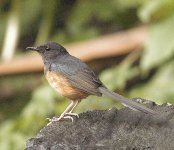I would like to have 900 or 1000mm of lens power or close to it.
With the 1.5 mag factor included in.
Hi:
This is a tough situation. I have the D70 and it's a nice camera. The problem with most birders is that they are quite fussy and feathers present a pretty good challenge for resolution and contrast. I've tried a number of cost effective things and have not been too happy. As someone said in this thread, if it were easy and cheap everybody would be banging out great bird shots. I think you can waste a lot of money running through unsatisfactory solutions.
Your millage may vary but I have not found a 2x tc that is up to birding.
The resolution suffers and you lose a lot of light.
You might go to a camera forum like here where a guy is using a Sigma 50-500 and 1.4. This combo might be among the cheapest alternatives for you.
http://forums.dpreview.com/forums/read.asp?forum=1030&message=11233822
Another good place to look is Fred Miranda's "Nature and Wildlife" section:
http://www.fredmiranda.com/forum/
I've been looking at a Sigma 500m used for about 2k like that here:
http://www.keh.com/shop/product.cfm?bid=NA&cid=08&sid=newused&crid=9273250
The trouble w/ hte Sigma 500mm is that you lose an f stop with a 1.4 tc (two f stops with a 2x)
and the lens is 4.5 to begin with. It will be difficult to take into the woods and get really great results.
The sad truth is that a good 1000m reach on a lens with a dslr is about 4-5k.
Then you need to have a good tripod and mount which isn't cheap either. Also, one of the real disadvantages of a D70 is that it does not have MLU (mirror lock up). At 1000m the movement of the mirror can cause troubles on a camera. Also the viewfinder is too small for really good manual focusing. Both of these are issues with good bird shots or any shots at 1000m. If you get a lens that requires manual focus, or like to use it as I do, you will likely find youself cursing the D70's viewfinder. (you lose auto focus with a lens sometimes if you add converters. Understand this before you buy!) These problems didn't stop me from getting the camera but they are two of the most glaring weaknesses on the camera and I think my next camera will resolve these issues.
You can go shorter then 1000mm but you need a lot more time, luck, and patience and skill. Rereading this I don't want to discourage you. You're not trying to submit prints to National Geographic and if you are dealing with 8x10(and smaller).... I've seen great shots with the "Bigma" 50-500 handheld. You'd likely have a ball with it. And it's not usually the lens but the person behind it.
Cheers,
Craig Ryder





